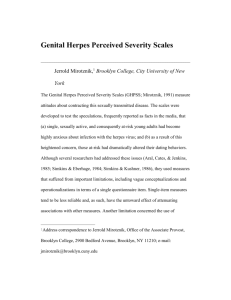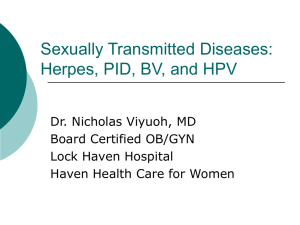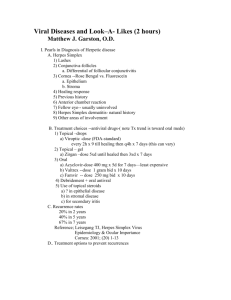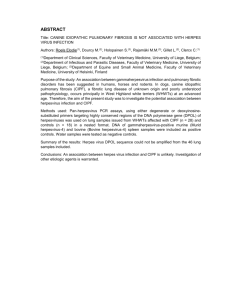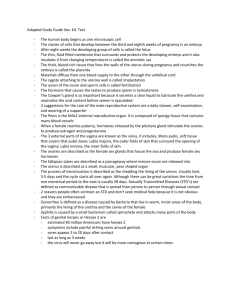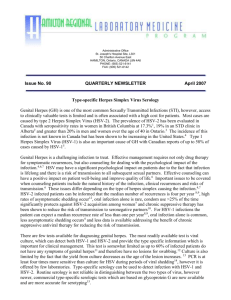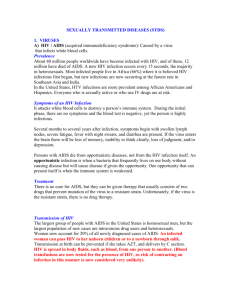European guidelines
advertisement
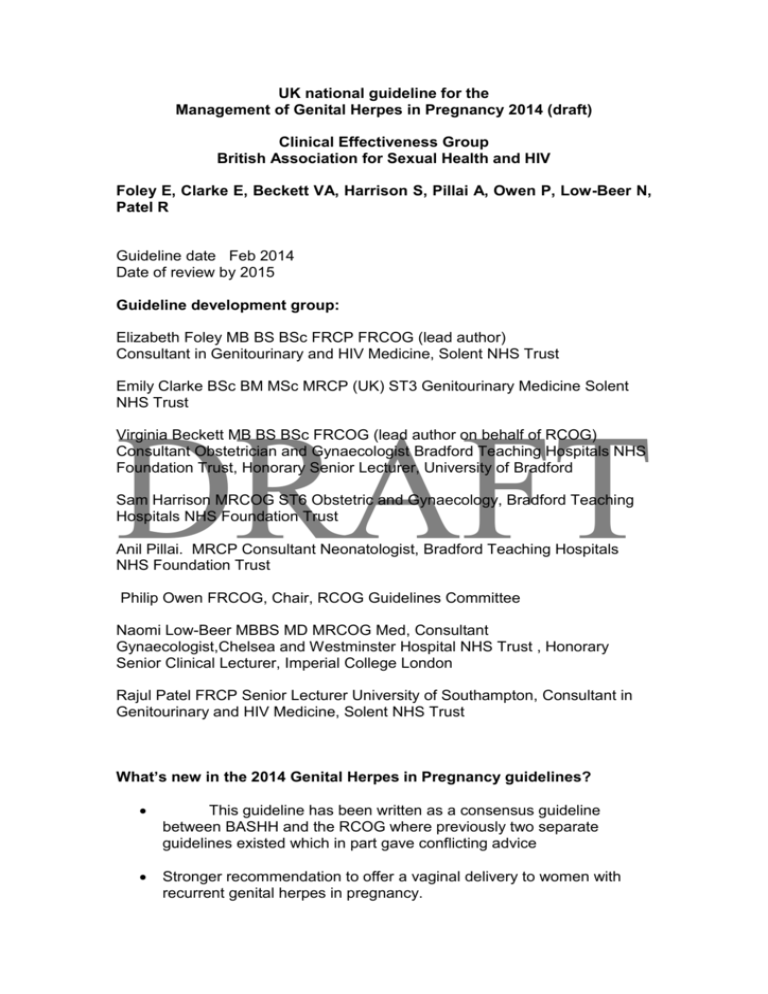
UK national guideline for the Management of Genital Herpes in Pregnancy 2014 (draft) Clinical Effectiveness Group British Association for Sexual Health and HIV Foley E, Clarke E, Beckett VA, Harrison S, Pillai A, Owen P, Low-Beer N, Patel R Guideline date Feb 2014 Date of review by 2015 Guideline development group: Elizabeth Foley MB BS BSc FRCP FRCOG (lead author) Consultant in Genitourinary and HIV Medicine, Solent NHS Trust Emily Clarke BSc BM MSc MRCP (UK) ST3 Genitourinary Medicine Solent NHS Trust Virginia Beckett MB BS BSc FRCOG (lead author on behalf of RCOG) Consultant Obstetrician and Gynaecologist Bradford Teaching Hospitals NHS Foundation Trust, Honorary Senior Lecturer, University of Bradford DRAFT Sam Harrison MRCOG ST6 Obstetric and Gynaecology, Bradford Teaching Hospitals NHS Foundation Trust Anil Pillai. MRCP Consultant Neonatologist, Bradford Teaching Hospitals NHS Foundation Trust Philip Owen FRCOG, Chair, RCOG Guidelines Committee Naomi Low-Beer MBBS MD MRCOG Med, Consultant Gynaecologist,Chelsea and Westminster Hospital NHS Trust , Honorary Senior Clinical Lecturer, Imperial College London Rajul Patel FRCP Senior Lecturer University of Southampton, Consultant in Genitourinary and HIV Medicine, Solent NHS Trust What’s new in the 2014 Genital Herpes in Pregnancy guidelines? This guideline has been written as a consensus guideline between BASHH and the RCOG where previously two separate guidelines existed which in part gave conflicting advice Stronger recommendation to offer a vaginal delivery to women with recurrent genital herpes in pregnancy. New section on genital herpes in pre term labour New section on the management of HIV positive women with genital herpes 1. Objective and scope In 2007 the British Association for Sexual Health and HIV (BASHH) published its guidance for the management of genital herpes (including a section on the management of genital herpes in pregnancy), and the Royal College of Obstetrics and Gynaecology (RCOG) published their green top guidelines on the management of genital herpes in pregnancy 1,2. In 2010 the European guideline for the management of genital herpes was published (also including a section on the management of herpes in pregnancy) 3. In order to achieve consensus it was felt that joint BASHH and RCOG guidelines for the management of herpes in pregnancy should be written to update the previous guidance from the two organisations. For more detailed information on the general management of genital herpes simplex infection in non-pregnant patients, this guideline should be considered in conjunction with the 2013 BASHH guidelines for the management of genital herpes (currently undergoing consultation). The scope of this guideline covers the inpatient and outpatient management of genital herpes simplex virus infection in the antenatal, intrapartum and postnatal periods of the mother. It also covers prevention of acquisition of maternal genital herpes simplex virus infection during pregnancy. The population covered by this guideline includes pregnant women with a suspected or confirmed diagnosis of genital herpes simplex infection in primary or secondary care. This guideline is aimed at health care professionals working in maternity units and departments offering level 3 care in STI management within the United Kingdom. However, the principles of the recommendations should be adopted across all services including community care. DRAFT Stakeholder involvement Clinicians from the Special Interest Group of BASHH and the RCOG guideline group have been involved in writing this guideline. The draft guidelines were sent for consultation to the Herpes Virus Association (HVA) for patient involvement. The guidelines will be posted on the BASHH and RCOG for 3 months for consultation with a direct request to the RCH for external peer review. 2. Search strategy This document was produced in accordance with the guidance set out in the CEG’s document ‘Framework for guideline development and assessment’ at http:/www.bashh.org/guidelines. A literature search was performed using Pubmed/Medline, Embase, Google, Cochrane Library, and relevant guidelines from January 1981 to May 2012. A Medline/Pubmed and Embase search was carried out from January 1981 to May 2012, using the following search terms/MESH headings: ‘HSV/herpes’, ‘genital ulcers’, ‘HSV/herpes pregnancy’, ‘neonatal HSV/herpes’, and ‘HSV/herpes drugs’, ‘pregnancy complications: infectious’, ‘Herpes genitalis’, and ‘Herpes simplex diagnosis’. The search was limited to humans and English language. For some specific recommendations an additional Medline/Pubmed search was performed when necessary. Google search was performed in April 2012 with the search term ‘HSV guideline(s)’ and all relevant documents of the first 150 search results were reviewed. A search of the Cochrane Library included Cochrane Database of Systematic Reviews, Database of Abstracts of Reviews of Effects and Cochrane Central Register of Controlled Trials. The following guidelines were reviewed in detail: 2010 European guideline for the management of genital herpes, 2007 British Association for Sexual Health and HIV guidance for the management of genital herpes, and 2007 Royal College of Obstetrics and Gynaecology green top guidelines on the management of genital herpes in pregnancy. The members of the guideline development group selected studies relevant to the scope of the guideline. Article titles and abstracts were reviewed and if relevant the full text article obtained. Priority was given to randomised controlled trial and systematic review evidence, and where possible recommendations made and graded on the basis of best available evidence.In areas where evidence is lacking recommendations based on consensus opinion within the writing group have been made. DRAFT 3. Background Neonatal herpes is a rare but serious viral infection with a high morbidity and mortality 4. It is classified into three subgroups in the infant depending on site of infection: Disease localised to skin, eye and/or mouth Local central nervous system (CNS) disease (encephalitis alone) Disseminated infection with multiple organ involvement Disease localised to skin, eye and/or mouth Infants who present with symptoms localised to the skin, eye, or mouth alone have the best prognosis and represent approximately 30% of neonatal herpes infections 5. Mortality is unusual and, with appropriate antiviral treatment, neurological and/or ocular morbidity is less than 2% 6. Local CNS disease and disseminated infection 70% of infants with neonatal herpes have disseminated and/or CNS infection, and approximately 60% of infants with local CNS and disseminated disease will present without skin, eye and/or mouth infection 5. Disseminated disease carries the worst prognosis: with appropriate antiviral treatment, mortality is around 30% and 17% having long-term neurological sequelae. Infants with local CNS disease often present late (generally between 10 days and 4 weeks of age). With antiviral treatment, mortality is around 6% and neurological morbidity 70%. The poor outcomes of disseminated and local CNS disease have been attributed to delays between symptom onset and treatment 6. Neonatal infection occurs as the result of an infection at the time of birth, in contrast congenital herpes is extremely rare and occurs by in utero transfer of infection. Incidence Neonatal herpes is very rare in the UK, in contrast to some other European countries and the USA. Active surveillance by the British Paediatric Surveillance Unit (BPSU) between 1986 and 1991 demonstrated 76 cases over the five and a half year surveillance period with an incidence of 1.65/100000 live births annually (95% CI 1.3–2.0) 7. Subsequent surveillance from 2004 to 2006 showed an approximate doubling of prevalence with 86 cases seen over the three-year surveillance period, although these data are still provisional 5. This increase may reflect the increase in prevalence of sexually transmitted diseases, demographic and social changes within the general population and improvements in diagnostic techniques 5. UK incidence is around 50% of that reported from other European countries and Japan. In the USA, the average reported incidence is one in 15000 but there is considerable variation between populations, and rates of up to one in 7500 have been reported in certain deprived inner city populations 6,8. DRAFT Aetiology Neonatal herpes may be caused by herpes simplex virus type 1 (HSV-1) or herpes simplex virus type 2 (HSV-2), as either viral type can cause genital herpes in the mother. Approximately 50% of neonatal herpes is due to HSV-1 and 50% due to HSV-2 5 Most cases of neonatal herpes occur as a result of direct contact with infected maternal secretions, although in 25% cases a possible source of postnatal infection was identified, usually a close relative of the mother 5,7. Transmission Factors associated with transmission include the type of maternal infection (primary or recurrent), the presence of transplacental maternal neutralising antibodies, the duration of rupture of membranes before delivery, the use of fetal scalp electrodes and mode of delivery 6,8. The risks are greatest when a woman acquires a new infection (primary genital herpes) in the third trimester, particularly within 6 weeks of delivery, as viral shedding may persist and the baby is likely to be born before the development of protective maternal antibodies 6,8. Very rarely, congenital herpes may occur as a result of transplacental intrauterine infection. Case reports suggest that the skin, eyes and central nervous system may be affected and there may be fetal growth restriction or fetal death 9–11. Disseminated herpes is more common in preterm infants and occurs almost exclusively as a result of primary infection in the mother. Although recurrent genital herpes is associated with a very low risk of neonatal herpes, recurrent herpes at the time of delivery which is commonly asymptomatic or unrecognised, may cause the localised forms of neonatal herpes, both local CNS disease and skin, eye and mouth infection. Transplacentally acquired HSV antibodies do not prevent neurogenic virus spreading to the brain of the neonate 12. Data from the USA suggest that around 2% of women acquire genital HSV infection in pregnancy 4, and most of these maternal infections are asymptomatic or unrecognised 4,8. However acquisition in the UK in pregnancy may vary markedly given differing rates of neonatal herpes in the UK and USA. It may be difficult to distinguish clinically between recurrent and primary genital HSV infections, as many first episode HSV infections are not true primary infections 13. Disseminated herpes infection in the mother Disseminated herpes, which may present with encephalitis, hepatitis, disseminated skin lesions or a combination of these conditions, is rare in adults. However it has been more commonly reported in pregnancy, particularly in the immunocompromised. The maternal mortality associated with this condition is high 14. All immunocompromised women, such as those infected with the HIV virus, are at increased risk of more severe and frequent symptomatic recurrent episodes of genital herpes during pregnancy and of asymptomatic shedding of HSV at term 15,16. As co-infection with HSV and HIV results in an increased replication of both viruses 17, there are concerns that genital reactivation of HSV may increase the risk of perinatal transmission of both HIV and HSV 15,16, although this has not been realised in practice in the UK. DRAFT For more detailed information on the diagnosis and management of herpes simplex virus infection in the mother, please refer to the BASHH 2013 herpes guidelines (http://www.bashh.org/guidelines). 4. Management of pregnant women with first episode genital herpes First or second trimester acquisition (until 27 completed weeks of pregnancy) There is no evidence of an increased risk of spontaneous miscarriage with primary genital herpes in the first trimester. (III) Women with suspected genital herpes should be referred to a genitourinary physician who will confirm or refute the diagnosis by viral PCR, advise on management of genital herpes and arrange a screen for other sexually transmitted infections. Treatment however should not be delayed. Management of the woman should be in line with her clinical condition and will usually involve the use of oral (or intravenous for disseminated HSV) aciclovir in standard doses (400mg tds, usually for five days). The use of aciclovir is associated with a reduction in the duration and severity of symptoms and a decrease in the duration of viral shedding. Aciclovir although unlicensed for use in pregnancy is considered safe and has not been associated with birth defects. Transient neonatal neutropenia 18–21 has been reported but no clinically significant adverse maternal or neonatal effects have been reported. Aciclovir is well tolerated in pregnancy. (IV) The obstetrician should be informed. Women with suspected genital herpes who are having midwifery-led care should be referred for review by an obstetrician, ideally after review by a genitourinary medicine physician. Providing that delivery does not ensue within the next 6 weeks, the pregnancy should be managed expectantly and vaginal delivery anticipated. There is no evidence that HSV acquired in pregnancy is associated with congenital abnormalities 22. (III) Following first or second trimester acquisition daily suppressive aciclovir 400mg tds from 36 weeks gestation reduces HSV lesions at term and hence the need for delivery by Caesarean section 23–28. It has also been shown to reduce asymptomatic viral shedding. Similar results have been seen with valaciclovir although valaciclovir is not recommended for use in pregnancy in view of lack of experience with its use 24,29,30. (Ib) Third trimester acquisition (from the 28th week of pregnancy) There is some evidence for increased perinatal morbidity (pre-term labour and low birth weight, together with stillbirth) 4,31, however the data are conflicting 4 so no additional monitoring of such pregnancies is recommended. There is insufficient evidence to suggest an association between HSV and stillbirth as a cause of fetal death 32; some studies showed no association 33. (III) Treatment should not be delayed. Management of the woman should be in line with her clinical condition and will usually involve the use of oral (or intravenous for disseminated HSV) aciclovir in standard doses (400mg tds, usually for five days). Usually women in the 3 rd trimester will continue daily suppressive aciclovir 400mg tds until delivery. Caesarean section (CS) should be the recommended choice of delivery for all women, particularly those developing symptoms within 6 weeks of expected delivery, as the risk of neonatal transmission of HSV is very high at 41%. 4,34–36. (IIb) It can be difficult to distinguish clinically between primary and recurrent genital HSV infections, as in up to 15% of cases where a woman presents with a first episode of clinical HSV infection, it will actually be a recurrent infection 13. For women presenting with first-episode genital herpes in the third trimester, particularly within 6 weeks of expected delivery, typespecific HSV antibody testing (immunoglobulin G antibodies to HSV-1 and HSV-2) is advisable. For these women, characterising the infection will influence the advice given regarding mode of delivery and risk of neonatal herpes. The presence of antibodies of the same type as the HSV isolated from genital swabs would confirm this episode to be a recurrence rather than a primary infection and elective CS would not be indicated to prevent neonatal transmission. However it should be noted that it may take 2-3 weeks for the results of this test. It is therefore recommended that an initial plan of delivery should be based on the assumption that all first episode lesions are primary genital herpes. This plan can then be DRAFT modified if HSV antibody test results subsequently confirm a recurrent, rather than primary infection. As interpretation of serology can be complicated, results should be discussed with a virologist or genitourinary physician. (IV) 5. Management of pregnant women with recurrent genital herpes Women with recurrent genital herpes should be informed that the risk of neonatal herpes is low, even if lesions are present at the time of delivery (0-3% for vaginal delivery). (III) Although there is no evidence that aciclovir is unsafe in early pregnancy the majority of recurrent episodes of genital herpes are short lasting and resolve within 7–10 days without antiviral treatment. Supportive treatment measures using saline bathing and analgesia alone will suffice. Vaginal delivery should be anticipated in the absence of other obstetric indications for CS. Daily suppressive aciclovir 400mg tds may be considered from 36 weeks gestation as it may reduce asymptomatic HSV shedding and HSV lesions at term. This, increase from the standard suppressive dose of 400mg bd, is recommended in view of the greater volume of distribution of the drug during pregnancy. 23,37. (Ia) Sequential PCR culture during late gestation to predict viral shedding at term 16, or at delivery to identify women who are asymptomatically shedding HSV, is not indicated. (IIa) There is no increased risk of pre-term labour (PTL), premature rupture of membranes or fetal growth restriction (FGR) associated with women seropositive for HSV. There are no congenital abnormalities associated with recurrent genital herpes infection 38. (IIa) DRAFT 6. Management of women with primary or recurrent genital lesions at onset of labour General management Management of a woman with genital herpes at the onset of labour will be based on clinical assessment as there will not be time for confirmatory laboratory testing. The clinician must take a history in order to ascertain whether this is a primary or recurrent episode. A viral swab from the lesion(s) should nonetheless be taken, as the result may influence management of the neonate. The neonatologist should be informed. Primary episode CS should be recommended to all women presenting with primary episode genital herpes lesions at the time of delivery, or within 6 weeks of the expected date of delivery, in order to reduce exposure of the fetus to HSV in genital secretions 8. (III) There is some evidence to suggest that the benefit of CS reduces if the membranes have been ruptured for greater than 4 hours (49). However, there may be some benefit in performing a CS even after this time frame. (III) Intravenous aciclovir given intrapartum to the mother (5mg/kg 8 hourly) and subsequently to the neonate may be considered for those mothers opting for vaginal delivery (12, 22). It is unknown whether intrapartum aciclovir reduces the risk of neonatal HSV infection. (IV) Where primary-episode genital herpes lesions are present at the time of delivery and the baby is delivered vaginally, the risk of neonatal herpes is estimated to be, 41% 4,34–36. (III) The risk of perinatal transmission depends on the timing of maternal acquisition of HSV, with the highest risk in infants born to women who have not completed HSV seroconversion during pregnancy (most commonly in the third trimester, within 6 weeks of delivery). (III) Although vaginal delivery should be avoided if possible, in women who deliver vaginally with primary genital herpes lesions present invasive procedures (fetal scalp electrodes, fetal blood sampling, artificial rupture of membranes and instrumental deliveries) should be avoided. (4,38,39). DRAFT Recurrent genital herpes Women presenting with recurrent genital herpes lesions at the onset of labour should be advised that the risk to the baby of neonatal herpes is very small (0-3% for vaginal delivery). (1,35) (III) Evidence from the Netherlands shows that a conservative approach, allowing vaginal delivery in the presence of an anogenital lesion, has not been associated with a rise in numbers of neonatal HSV cases 41. (III) Vaginal delivery should be offered to women with recurrent genital herpes lesions at the onset of labour. A CS delivery can be considered but the risk to the mother and future pregnancies should be set against the very small risk of neonatal transmission of HSV with recurrent disease (0-3% for vaginal delivery). The final choice of vaginal delivery versus CS should be made by the mother, who should base her decision on the very low risk of transmission set against any other obstetric risk factors, and the risk of CS. (IV) It has been reported that invasive procedures (fetal blood sampling, fetal scalp electrodes, artificial rupture of membranes and instrumental deliveries) increase the risk of neonatal HSV infection (4). However given the very small background risk (0-3%) of transmission in this group, the increased risk associated with invasive procedures is unlikely to be clinically significant. (III) Women should be managed in accordance with standard NICE intrapartum guidelines 42. There is no evidence to guide the management of women with spontaneous rupture of membranes (SROM) at term, but many clinicians will advise expediting delivery in an attempt to minimise the duration of exposure of the infant to HSV. (IV) 7. Genital herpes in preterm labour (before 37 completed weeks of pregnancy) Primary genital herpes in preterm prelabour rupture of membranes (PPROM) There is limited evidence to inform best obstetric practice when PPROM is complicated by primary HSV infection. Management should be guided by multi-disciplinary team discussion involving the obstetricians, neonatologists and genitourinary medicine physicians and will depend on the gestation that PPROM occurred. If the decision is made for immediate delivery then the benefits of CS will still be valid. If there is initial conservative management the mother should be given IV aciclovir 5mg/kg 8 hourly and prophylactic steroids should be considered for the baby as per standard RCOG management. If delivery is indicated within 6 weeks of the primary infection delivery by CS may still offer some benefit despite prolonged rupture of membranes 43–45. (IV) The infant should be screened for HSV infection and consideration given to aciclovir therapy. DRAFT Recurrent genital herpes In PPROM in the presence of recurrent genital herpes lesions, the risk of neonatal transmission is very small and is likely to be outweighed by the morbidity and mortality associated with premature delivery. In case of PPROM before 32-34 weeks there is evidence to suggest that expectant management is appropriate including oral aciclovir 400mg tds for the mother. After this gestation it is recommended that management is undertaken in accordance with RCOG Guidelines for PPROM and antenatal corticosteroid use to reduce neonatal morbidity and mortality, and is not influenced by the presence of recurrent genital herpes lesions 43,46. (IV) 8. Management of HIV positive women with HSV infection Primary HSV infection HIV positive women with primary genital HSV infection in the last trimester of pregnancy should be managed in according to the recommendations for all women with primary genital HSV infection. Recurrent HSV infection There is some evidence that HIV antibody positive women with genital HSV ulceration in pregnancy are more likely to transmit HIV infection independent of other factors 16,47. However, this is not a consistent finding across all studies 48. (III) Women who are HIV antibody positive and have a history of genital herpes should be offered daily suppressive aciclovir 400mg tds from 32 weeks gestation to reduce the risk of transmission of HIV infection especially in women where a vaginal delivery is planned. Starting therapy at this earlier gestation than usual should be considered in view of the increased possibility of preterm labour in HIV positive women. (IV) The mode of delivery should be in line with the BHIVA/RCOG HIV in pregnancy guideline recommendation according to obstetric factors and HIV parameters – HIV viral load etc 49 . There is currently no evidence to recommend daily suppressive treatment for HIV antibody positive women who are HSV 1 or 2 seropositive but have no history of genital herpes 48. 9. Management of the neonate DRAFT General management In all cases the neonatal team should be informed Management t of babies born by CS in mothers with primary HSV infection in the third trimester These babies are at very low risk of vertical transmitted HSV infection so conservative management is advised Liaise with the neonatal team. Swabs from the neonate are not indicated. No active treatment is required for the baby Normal postnatal care of the baby is advised with a neonatal examination at 24 hours of age, after which the baby can be discharged from the hospital if well and feeding is established. Parental education regarding good hand hygiene and due care to reduce risk of postnatal infection. Parents should be advised to seek medical help if they have concerns regarding their baby. In particular they should be advised to look for: o Skin, eye and mucous membrane lesions, lethargy/irritability, poor feeding Management of babies born by spontaneous vaginal delivery in mothers with a primary HSV infection within the previous 6 weeks These babies are at high risk of vertically transmitted HSV infection. Liaise with the neonatal team. If the baby is well: Swabs of the skin, conjunctiva, oropharynx and rectum should be sent for herpes simplex PCR. A lumbar puncture is not necessary. Consider empirical intravenous aciclovir (20mg/kg 3 times a day for 10 days whilst waiting for the results Strict infection control procedures should be put in place for both mother and baby. Breast-feeding is recommended unless the mother has herpetic lesions around the nipples. Parents should be warned to report any early signs of infection such as poor feeding, lethargy, fever or any suspicious lesions If the baby is unwell or presents with skin lesions Swabs of the skin, lesions, conjunctiva, orpharynx and rectum should be sent for Herpes simplex PCR. A lumbar puncture should be performed even if CNS features are not present Intravenous aciclovir (20mg/kg 3 times a day should be commenced whilst awaiting results DRAFT Management of babies born to mothers with recurrent HSV infection in pregnancy +/-active lesions at delivery In the case of recurrent genital herpes infections in the mother, maternal IgG will be protective in the baby and hence the infection risk is low. Conservative management of the neonate is advised (47). (III) Liaise with the neonatal team. Surface swabs from the neonate are not indicated. No active treatment is advised for the baby. Normal postnatal care of the baby is advised with a neonatal examination at 24 hours of age, after which the baby can be discharged from the hospital if well and feeding is established. Parental education regarding good hand hygiene and due care to reduce risk of postnatal infection. Parents should be advised to seek medical help if they have concerns regarding their baby. In particular they should be advised to look for: o Skin, eye and mucous membrane lesions, lethargy/irritability, poor feeding In cases where there are concerns regarding the neonate (Clinical evidence of sepsis, poor feeding) Liaise with the neonatal team. In addition to considering bacterial sepsis HSV infection should be considered. Surface swabs and blood for HSV culture and PCR Intravenous aciclovir while awaiting cultures. Further management by the neonatal team according to condition of the baby and test results. 10. Prevention of postnatal transmission In 25% cases a possible source of postnatal infection was identified, usually a close relative of the mother (2). Efforts to prevent postnatal transmission of HSV are therefore important and advice should be given to the mother regarding this. Breast-feeding is recommended unless the mother has herpetic lesions around the nipples. The mother and all those with herpetic lesions in contact with the neonate, including staff, should practice careful hand hygiene. Those with oral herpetic lesions (cold sores) should not kiss the neonate. (IV) DRAFT 11. Safety of aciclovir and other antivirals in pregnancy None of the antiviral drugs is licensed for use in pregnancy. Aciclovir although unlicensed for use in pregnancy is considered safe and has not been associated with birth defects. Transient neonatal neutropenia 18–21 has been reported but no clinically significant adverse maternal or neonatal effects have been reported. Aciclovir is well tolerated in pregnancy and for treatment courses no dose adjustment is necessary. 50,51. There is no evidence of an increased risk of birth defects with aciclovir, famciclovir nor valaciclovir if used in the first trimester. 21. (III) Safety data for aciclovir may be extrapolated to valaciclovir in late pregnancy, as it is the valine ester, but as there is less experience with the use of valaciclovir or famciclovir they are not recommended as a first line treatment. 21 Auditable measures 1. All women with signs or symptoms suggestive of genital herpes in pregnancy should have a viral swab taken for HSV PCR – target 95% 2. There should be a documented discussion regarding mode of delivery with the obstetrician – target 100% 2. For women with suspected primary genital herpes in pregnancy referral to a genitourinary medicine physician should be made (unless in labour) – target 100% 3. Where a diagnosis of genital herpes is made in third trimester, referral to a neonatologist should be made – target 100% 4. There should be a MDT discussion of all confirmed cases of neonatal herpes – target 100% Qualifying statement The recommendations in this guideline may not be appropriate for use in all clinical situations. Decisions to follow these recommendations must be based on the professional judgment of the clinician and consideration of individual patient circumstances and available resources. All possible care has been undertaken to ensure the publication of the correct dosage of medication and route of administration. However, it remains the responsibility of the prescribing clinician to ensure the accuracy and appropriateness of the medication they prescribe. Editorial independence This guideline was commissioned, edited and endorsed by the BASHH CEG and the RCOG without external funding being sought or obtained. DRAFT Declarations of interest All members of the guideline writing committee completed the BASHH conflict of interest declaration detailed below at the time the guideline’s final draft was submitted to the CEG. Dr Rajul Patel has received honoraria for talks and fees for consultancy from Novatis, Becton Dickinson and Roche pharmaceutical and diagnostic companies. Resource implications The resources implication of this guideline will have little impact on current recommendation for management of herpes in pregnancy. There may be a cost saving if women elect to have a vaginal delivery when herpetic lesions are present at term rather than undergoing a CS. The cost of suppressive aciclovir for 1 year is as guidelines recommend is £160.74*. *Source of costing DMG tariff BNF September 2010 (Different prices may be negotiated by NHS hospital trusts) Membership of the writing Group EF and EC drafted the initial document and redrafted the guideline, VAB and SH drafted and redrafted the obstetric component and AP drafted the neonatal section. PO, NLB and RP commented on the drafts and redrafts of the document. Membership of the CEG • Dr Keith Radcliffe (Chair); Consultant Physician in Genitourinary Medicine Whittall Street Clinic • Dr David Daniels, West Middlesex University Hospitals NHS Trust, Sexual Health Clinic West Middlesex Hospital • Dr Mark FitzGerald Consultant Physician in Genitourinary Medicine, Musgrove Park Hospital • Dr Deepa Grover, Consultant in Genitourinary/HIV Medicine Barnet General Hospital/Royal Free Hospital • Dr Stephen Higgins, Consultant Physician in Genitourinary Medicine, North Manchester General Hospital, Manchester • Dr Margaret Kingston, Consultant Physician in GU Medicine, Manchester Centre for Sexual Health • Dr Neil Lazaro, Associate Specialist in GU Medicine, Royal Preston Hospital, • Dr Louise Melville, Consultant Sexual Health Glasgow DRAFT • Dr Ann Sullivan, Consultant Physician in Genitourinary Medicine, Chelsea & Westminster Healthcare NHS Trust, Timescale for next review 2015. Date to be finalised by the RCOG Guidelines committee depending on developments in the evidence. Acknowledgements We are grateful to Marian Nicholson from the Herpes Virus Association (HVA) for her invaluable input with this guideline. References 1. Low-Beer N, Kinghorn G. Green-top Guideline No. 30 Management of Genital Herpes in Pregnancy. Royal College of Obstetricians and Gynaecologists [Internet]. 2007;(30):1–9. Available from: http://www.rcog.org.uk/womens-health/clinical-guidance/managementgenital-herpes-pregnancy-green-top-30 2. Clinical Effectiveness Group (British Association for Sexual Health and HIV). 2007 National Guideline for the Management of Genital Herpes. 2007;1–26. Available from: http://www.bashh.org/documents/115/115.pdf 3. Patel R, Alderson S, Geretti A, Nilsen A, Foley E, Lautenschlager S, et al. 2010 European guideline for the management of genital herpes. 2010;(Cdc). Available from: http://www.iusti.org/regions/europe/pdf/2010/Euro_Guideline_2010_her pes.pdf 4. Brown ZA, Selke S, Zeh J, Kopelman J, Maslow A, Ashley RL, et al. The acquisition of herpes simplex virus during pregnancy. The New England journal of medicine [Internet]. 1997 Aug 21 [cited 2012 May 18];337(8):509–15. Available from: http://www.ncbi.nlm.nih.gov/pubmed/9262493 5. BPSU 21st Annual Report 2006-1007 [Internet]. [cited 2013 Apr 29]. Available from: http://webappmk.doctors.org.uk/Session/553076z5CcsqyQc34TD48RwKr8-aopxkih/MIME/INBOX/9114-02-01-02B/BPSU_AR_2006to7.pdf 6. Brown Z. Preventing herpes simplex virus transmission to the neonate. Herpes : the journal of the IHMF [Internet]. 2004 Aug [cited 2012 Nov 15];11 Suppl 3:175A–186A. Available from: http://www.ncbi.nlm.nih.gov/pubmed/15319088 7. Tookey P, Peckham CS. Neonatal herpes simplex virus infection in the British Isles. Paediatric and perinatal epidemiology [Internet]. 1996 Oct [cited 2012 Nov 15];10(4):432–42. Available from: http://www.ncbi.nlm.nih.gov/pubmed/8931058 8. Brown ZA, Wald A, Morrow RA, Selke S, Zeh J, Corey L. Effect of serologic status and cesarean delivery on transmission rates of herpes simplex virus from mother to infant. JAMA : the journal of the American Medical Association [Internet]. 2003 Jan 8 [cited 2012 May 18];289(2):203–9. Available from: http://www.ncbi.nlm.nih.gov/pubmed/12517231 DRAFT 9. Diguet A, Patrier S, Eurin D, Chouchene S, Marpeau L, Laquerrière A, et al. Prenatal diagnosis of an exceptional intrauterine herpes simplex type 1 infection. Prenatal diagnosis [Internet]. 2006 Feb [cited 2012 Nov 15];26(2):154–7. Available from: http://www.ncbi.nlm.nih.gov/pubmed/16463294 10. Vasileiadis GT, Roukema HW, Romano W, Walton JC, Gagnon R. Intrauterine herpes simplex infection. American journal of perinatology [Internet]. 2003 Feb [cited 2012 Nov 15];20(2):55–8. Available from: http://www.ncbi.nlm.nih.gov/pubmed/12660908 11. Lee A, Bar-Zeev N, Walker SP, Permezel M. In utero herpes simplex encephalitis. Obstetrics and gynecology [Internet]. 2003 Nov [cited 2012 Nov 15];102(5 Pt 2):1197–9. Available from: http://www.ncbi.nlm.nih.gov/pubmed/14607055 12. Nahmias AJ. Neonatal HSV infection Part I: continuing challenges. Herpes : the journal of the IHMF [Internet]. 2004 Aug [cited 2012 Nov 15];11(2):33–7. Available from: http://www.ncbi.nlm.nih.gov/pubmed/15955265 13. Hensleigh PA, Andrews WW, Brown Z, Greenspoon J, Yasukawa L, Prober CG. Genital herpes during pregnancy: inability to distinguish primary and recurrent infections clinically. Obstetrics and gynecology [Internet]. 1997 Jun [cited 2012 May 18];89(6):891–5. Available from: http://www.ncbi.nlm.nih.gov/pubmed/9170460 14. Young EJ, Chafizadeh E, Oliveira VL, Genta RM. Disseminated herpesvirus infection during pregnancy. Clinical infectious diseases : an official publication of the Infectious Diseases Society of America [Internet]. 1996 Jan [cited 2012 Nov 15];22(1):51–8. Available from: http://www.ncbi.nlm.nih.gov/pubmed/8824966 15. Hitti J, Watts DH, Burchett SK, Schacker T, Selke S, Brown ZA, et al. Herpes simplex virus seropositivity and reactivation at delivery among pregnant women infected with human immunodeficiency virus-1. American journal of obstetrics and gynecology [Internet]. 1997 Aug [cited 2012 May 18];177(2):450–4. Available from: http://www.ncbi.nlm.nih.gov/pubmed/9290467 16. Chen KT, Segú M, Lumey LH, Kuhn L, Carter RJ, Bulterys M, et al. Genital herpes simplex virus infection and perinatal transmission of human immunodeficiency virus. Obstetrics and gynecology [Internet]. 2005 Dec [cited 2012 May 18];106(6):1341–8. Available from: http://www.ncbi.nlm.nih.gov/pubmed/16319261 17. Heng MC, Heng SY, Allen SG. Co-infection and synergy of human immunodeficiency virus-1 and herpes simplex virus-1. Lancet [Internet]. 1994 Jan 29 [cited 2012 May 18];343(8892):255–8. Available from: http://www.ncbi.nlm.nih.gov/pubmed/7905094 DRAFT 18. Andrews WW, Kimberlin DF, Whitley R, Cliver S, Ramsey PS, Deeter R. Valacyclovir therapy to reduce recurrent genital herpes in pregnant women. American journal of obstetrics and gynecology [Internet]. 2006 Mar [cited 2012 Apr 3];194(3):774–81. Available from: http://www.ncbi.nlm.nih.gov/pubmed/16522412 19. Stone KM, Reiff-Eldridge R, White AD, Cordero JF, Brown Z, Alexander ER, et al. Pregnancy outcomes following systemic prenatal acyclovir exposure: Conclusions from the international acyclovir pregnancy registry, 1984-1999. Birth defects research Part A, Clinical and molecular teratology [Internet]. 2004 Apr [cited 2012 May 18];70(4):201–7. Available from: http://www.ncbi.nlm.nih.gov/pubmed/15108247 20. Ratanajamit C, Vinther Skriver M, Jepsen P, Chongsuvivatwong V, Olsen J, Sørensen HT. Adverse pregnancy outcome in women exposed to acyclovir during pregnancy: a population-based observational study. Scandinavian journal of infectious diseases [Internet]. 2003 Jan [cited 2012 May 18];35(4):255–9. Available from: http://www.ncbi.nlm.nih.gov/pubmed/12839155 21. Pasternak B, Hviid A. Use of acyclovir, valacyclovir, and famciclovir in the first trimester of pregnancy and the risk of birth defects. JAMA : the journal of the American Medical Association [Internet]. 2010 Aug 25 [cited 2012 Mar 4];304(8):859–66. Available from: http://www.ncbi.nlm.nih.gov/pubmed/20736469 22. Acs N, Bánhidy F, Puhó E, Czeizel AE. No association between maternal recurrent genital herpes in pregnancy and higher risk for congenital abnormalities. Acta obstetricia et gynecologica Scandinavica [Internet]. 2008 Jan [cited 2012 Nov 15];87(3):292–9. Available from: http://www.ncbi.nlm.nih.gov/pubmed/18307068 23. Sheffield JS, Hollier LM, Hill JB, Stuart GS, Wendel GD. Acyclovir prophylaxis to prevent herpes simplex virus recurrence at delivery: a systematic review. Obstetrics and gynecology [Internet]. 2003 Dec [cited 2012 May 18];102(6):1396–403. Available from: http://www.ncbi.nlm.nih.gov/pubmed/14662233 24. Watts DH, Brown ZA, Money D, Selke S, Huang ML, Sacks SL, et al. A double-blind, randomized, placebo-controlled trial of acyclovir in late pregnancy for the reduction of herpes simplex virus shedding and cesarean delivery. American journal of obstetrics and gynecology [Internet]. 2003 Mar [cited 2012 May 18];188(3):836–43. Available from: http://www.ncbi.nlm.nih.gov/pubmed/12634667 25. Scott LL, Hollier LM, McIntire D, Sanchez PJ, Jackson GL, Wendel GD. Acyclovir suppression to prevent recurrent genital herpes at delivery. Infectious diseases in obstetrics and gynecology [Internet]. 2002 Jan [cited 2012 May 18];10(2):71–7. Available from: http://www.pubmedcentral.nih.gov/articlerender.fcgi?artid=1784606&too l=pmcentrez&rendertype=abstract 26. Brocklehurst P, Kinghorn G, Carney O, Helsen K, Ross E, Ellis E, et al. A randomised placebo controlled trial of suppressive acyclovir in late pregnancy in women with recurrent genital herpes infection. British journal of obstetrics and gynaecology [Internet]. 1998 Mar [cited 2012 May 18];105(3):275–80. Available from: http://www.ncbi.nlm.nih.gov/pubmed/9532986 DRAFT 27. Scott LL, Sanchez PJ, Jackson GL, Zeray F, Wendel GD. Acyclovir suppression to prevent cesarean delivery after first-episode genital herpes. Obstetrics and gynecology [Internet]. 1996 Jan [cited 2012 May 18];87(1):69–73. Available from: http://www.ncbi.nlm.nih.gov/pubmed/8532270 28. Braig S, Luton D, Sibony O, Edlinger C, Boissinot C, Blot P, et al. Acyclovir prophylaxis in late pregnancy prevents recurrent genital herpes and viral shedding. European journal of obstetrics, gynecology, and reproductive biology [Internet]. 2001 May [cited 2012 May 18];96(1):55–8. Available from: http://www.ncbi.nlm.nih.gov/pubmed/11311761 29. Sheffield JS, Hill JB, Hollier LM, Laibl VR, Roberts SW, Sanchez PJ, et al. Valacyclovir prophylaxis to prevent recurrent herpes at delivery: a randomized clinical trial. Obstetrics and gynecology [Internet]. 2006 Jul [cited 2012 May 18];108(1):141–7. Available from: http://www.ncbi.nlm.nih.gov/pubmed/16816068 30. Hollier LM, Wendel GD. Third trimester antiviral prophylaxis for preventing maternal genital herpes simplex virus (HSV) recurrences and neonatal infection. Cochrane database of systematic reviews (Online) [Internet]. 2008 Jan [cited 2012 Mar 27];(1):CD004946. Available from: http://www.ncbi.nlm.nih.gov/pubmed/18254066 31. Brown ZA, Benedetti J, Selke S, Ashley R, Watts DH, Corey L. Asymptomatic maternal shedding of herpes simplex virus at the onset of labor: relationship to preterm labor. Obstetrics and gynecology [Internet]. 1996 Apr [cited 2012 Nov 15];87(4):483–8. Available from: http://www.ncbi.nlm.nih.gov/pubmed/8602295 32. Syridou G, Spanakis N, Konstantinidou A, Piperaki E-T, Kafetzis D, Patsouris E, et al. Detection of cytomegalovirus, parvovirus B19 and herpes simplex viruses in cases of intrauterine fetal death: association with pathological findings. Journal of medical virology [Internet]. 2008 Oct [cited 2012 Nov 15];80(10):1776–82. Available from: http://www.ncbi.nlm.nih.gov/pubmed/18712818 33. Eskild A, Jeansson S, Stray-Pedersen B, Jenum PA. Herpes simplex virus type-2 infection in pregnancy: no risk of fetal death: results from a nested case-control study within 35,940 women. BJOG : an international journal of obstetrics and gynaecology [Internet]. 2002 Sep [cited 2012 Nov 15];109(9):1030–5. Available from: http://www.ncbi.nlm.nih.gov/pubmed/12269678 34. Brown ZA, Vontver LA, Benedetti J, Critchlow CW, Sells CJ, Berry S, et al. Effects on infants of a first episode of genital herpes during pregnancy. The New England journal of medicine [Internet]. 1987 Nov 12 [cited 2012 May 18];317(20):1246–51. Available from: http://www.ncbi.nlm.nih.gov/pubmed/2823137 DRAFT 35. Arvin AM, Hensleigh PA, Prober CG, Au DS, Yasukawa LL, Wittek AE, et al. Failure of antepartum maternal cultures to predict the infant’s risk of exposure to herpes simplex virus at delivery. The New England journal of medicine [Internet]. 1986 Sep 25 [cited 2012 May 18];315(13):796–800. Available from: http://www.ncbi.nlm.nih.gov/pubmed/3018565 36. Brown ZA, Benedetti J, Ashley R, Burchett S, Selke S, Berry S, et al. Neonatal herpes simplex virus infection in relation to asymptomatic maternal infection at the time of labor. The New England journal of medicine [Internet]. 1991 May 2 [cited 2012 May 18];324(18):1247–52. Available from: http://www.ncbi.nlm.nih.gov/pubmed/1849612 37. Gardella C, Brown ZA, Wald A, Morrow RA, Selke S, Krantz E, et al. Poor correlation between genital lesions and detection of herpes simplex virus in women in labor. Obstetrics and gynecology [Internet]. 2005 Aug [cited 2012 May 18];106(2):268–74. Available from: http://www.ncbi.nlm.nih.gov/pubmed/16055574 38. Kim ID, Chang HS, Hwang KJ. Herpes simplex virus 2 infection rate and necessity of screening during pregnancy: a clinical and seroepidemiologic study. Yonsei medical journal [Internet]. 2012 Mar [cited 2012 May 18];53(2):401–7. Available from: http://www.pubmedcentral.nih.gov/articlerender.fcgi?artid=3282958&too l=pmcentrez&rendertype=abstract 39. Corey L, Fife KH, Benedetti JK, Winter CA, Fahnlander A, Connor JD, et al. Intravenous acyclovir for the treatment of primary genital herpes. Annals of internal medicine [Internet]. 1983 Jun [cited 2012 May 18];98(6):914–21. Available from: http://www.ncbi.nlm.nih.gov/pubmed/6305244 40. Amann ST, Fagnant RJ, Chartrand SA, Monif GR. Herpes simplex infection associated with short-term use of a fetal scalp electrode. A case report. The Journal of reproductive medicine [Internet]. 1992 Apr [cited 2012 May 18];37(4):372–4. Available from: http://www.ncbi.nlm.nih.gov/pubmed/1593564 41. Singhal P, Naswa S, Marfatia YS. Pregnancy and sexually transmitted viral infections. Indian journal of sexually transmitted diseases [Internet]. 2009 Jul [cited 2012 May 18];30(2):71–8. Available from: http://www.pubmedcentral.nih.gov/articlerender.fcgi?artid=3168062&too l=pmcentrez&rendertype=abstract 42. NICE. CG55 Intrapartum care: NICE guideline [Internet]. NICE; [cited 2013 Apr 29]. Available from: http://publications.nice.org.uk/intrapartumcare-cg55 43. Major CA, Towers C V, Lewis DF, Garite TJ. Expectant management of preterm premature rupture of membranes complicated by active recurrent genital herpes. American journal of obstetrics and gynecology [Internet]. 2003 Jun [cited 2012 May 18];188(6):1551–4; discussion 1554–5. Available from: http://www.ncbi.nlm.nih.gov/pubmed/12824992 DRAFT 44. Utley K, Bromberger P, Wagner L, Schneider H. Management of primary herpes in pregnancy complicated by ruptured membranes and extreme prematurity: case report. Obstetrics and gynecology [Internet]. 1987 Mar [cited 2012 Nov 15];69(3 Pt 2):471–3. Available from: http://www.ncbi.nlm.nih.gov/pubmed/3808528 45. Dietrich YM, Napolitano PG. Acyclovir treatment of primary herpes in pregnancy complicated by second trimester preterm premature rupture of membranes with term delivery: case report. American journal of perinatology [Internet]. 2002 Jul [cited 2012 Nov 15];19(5):235–8. Available from: http://www.ncbi.nlm.nih.gov/pubmed/12152140 46. Ehsanipoor RM, Major CA. Herpes simplex and HIV infections and preterm PROM. Clinical obstetrics and gynecology [Internet]. 2011 Jun [cited 2012 May 18];54(2):330–6. Available from: http://www.ncbi.nlm.nih.gov/pubmed/21508703 47. Drake AL, John-Stewart GC, Wald A, Mbori-Ngacha DA, Bosire R, Wamalwa DC, et al. Herpes simplex virus type 2 and risk of intrapartum human immunodeficiency virus transmission. Obstetrics and gynecology [Internet]. 2007 Feb [cited 2012 May 18];109(2 Pt 1):403–9. Available from: http://www.ncbi.nlm.nih.gov/pubmed/17267842 48. Chen KT, Tuomala RE, Chu C, Huang M-L, Watts DH, Zorrilla CD, et al. No association between antepartum serologic and genital tract evidence of herpes simplex virus-2 coinfection and perinatal HIV-1 transmission. American journal of obstetrics and gynecology [Internet]. 2008 Apr [cited 2012 May 18];198(4):399.e1–5. Available from: http://www.ncbi.nlm.nih.gov/pubmed/18177832 49. Taylor GP, Clayden P, Dhar J, Gandhi K, Gilleece Y, Harding K, et al. British HIV Association guidelines for the management of HIV infection in pregnant women 2012. HIV medicine [Internet]. 2012 Sep [cited 2012 Nov 12];13 Suppl 2:87–157. Available from: http://www.ncbi.nlm.nih.gov/pubmed/22830373 50. Frenkel LM, Brown ZA, Bryson YJ, Corey L, Unadkat JD, Hensleigh PA, et al. Pharmacokinetics of acyclovir in the term human pregnancy and neonate. American journal of obstetrics and gynecology [Internet]. 1991 Feb [cited 2012 May 18];164(2):569–76. Available from: http://www.ncbi.nlm.nih.gov/pubmed/1847004 51. Kimberlin DF, Weller S, Whitley RJ, Andrews WW, Hauth JC, Lakeman F, et al. Pharmacokinetics of oral valacyclovir and acyclovir in late pregnancy. American journal of obstetrics and gynecology [Internet]. 1998 Oct [cited 2012 May 18];179(4):846–51. Available from: http://www.ncbi.nlm.nih.gov/pubmed/9790357 Appendix I: Levels of evidence and grading of recommendations Level of evidence Ia Meta-analysis of randomised controlled trials Ib At least one randomised controlled trial IIa At least one well designed controlled study without randomisation IIb At least one other type of well designed quasi-experimental study III Well designed non-experimental descriptive studies IV Expert committee reports or opinions of respected authorities Grading of recommendation A Evidence at level Ia or Ib B Evidence at level IIa, IIb or III C Evidence at level IV DRAFT

